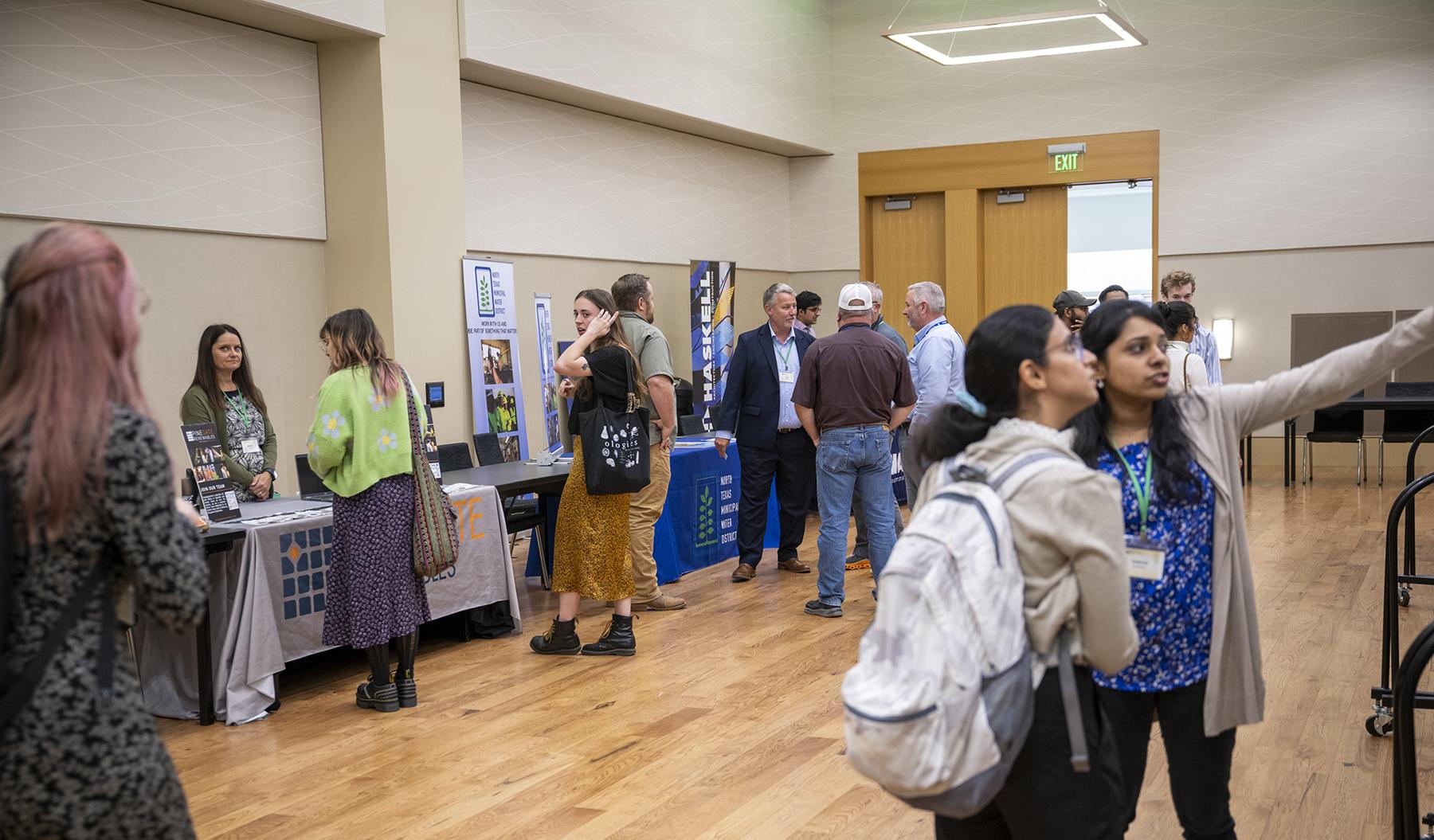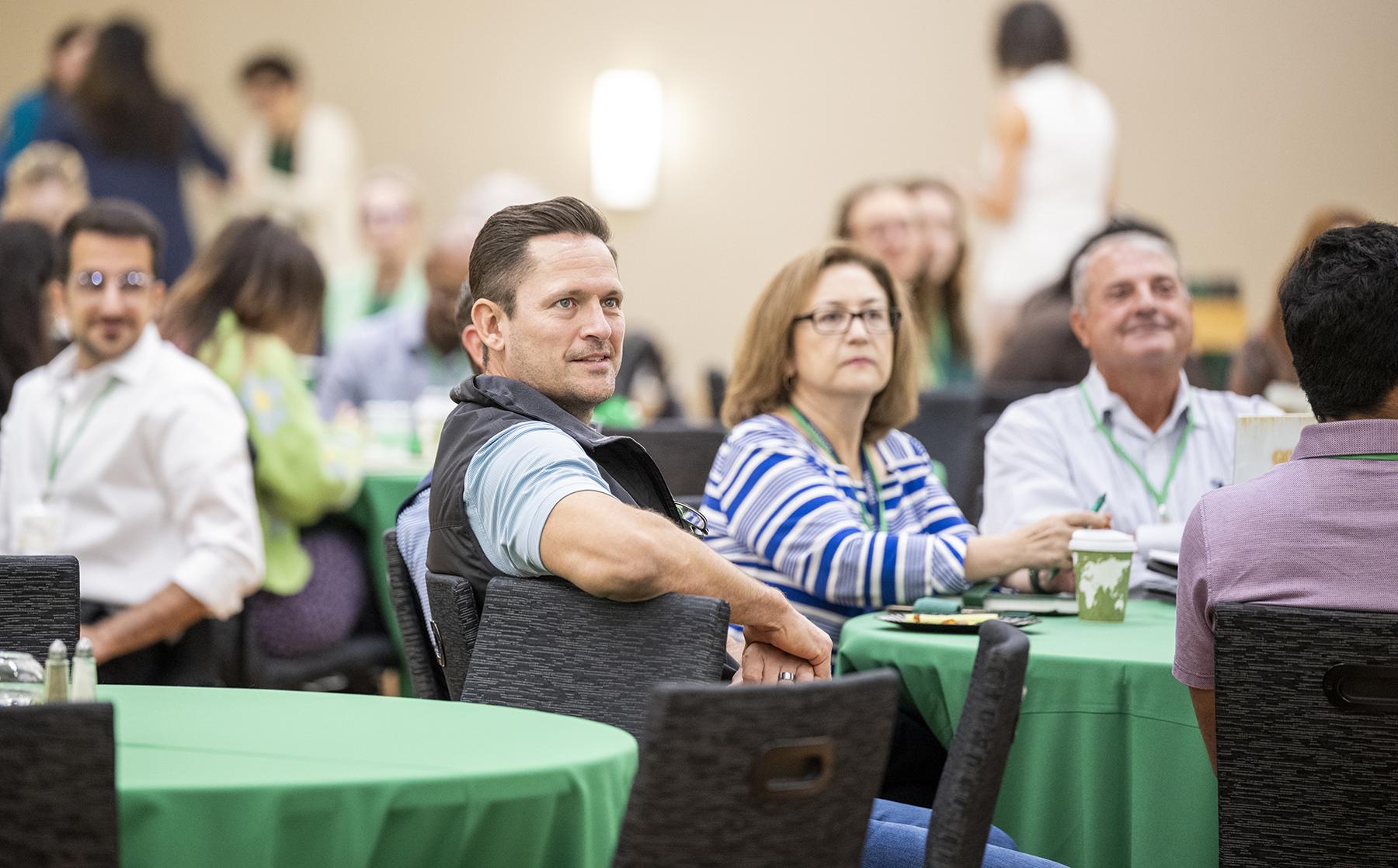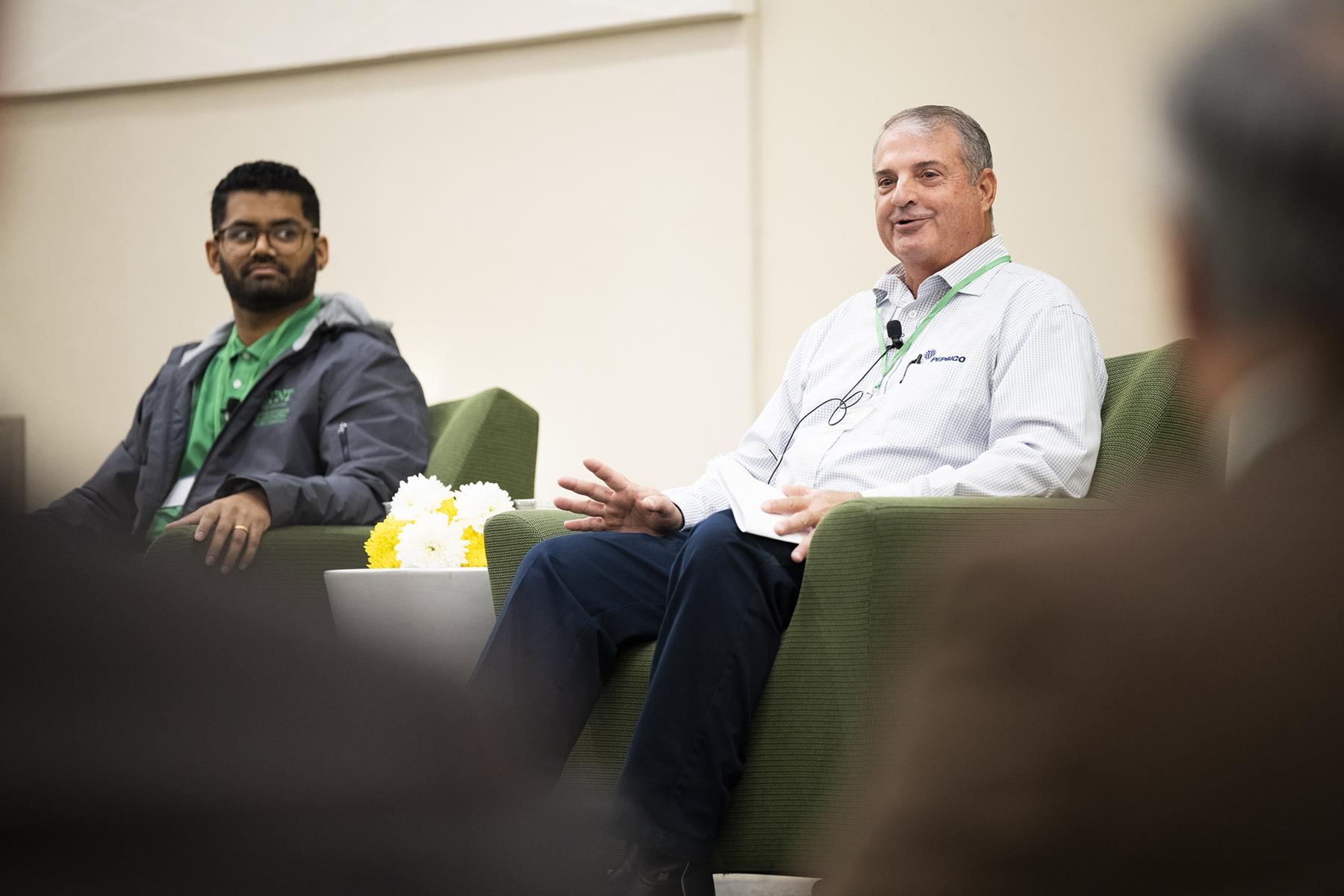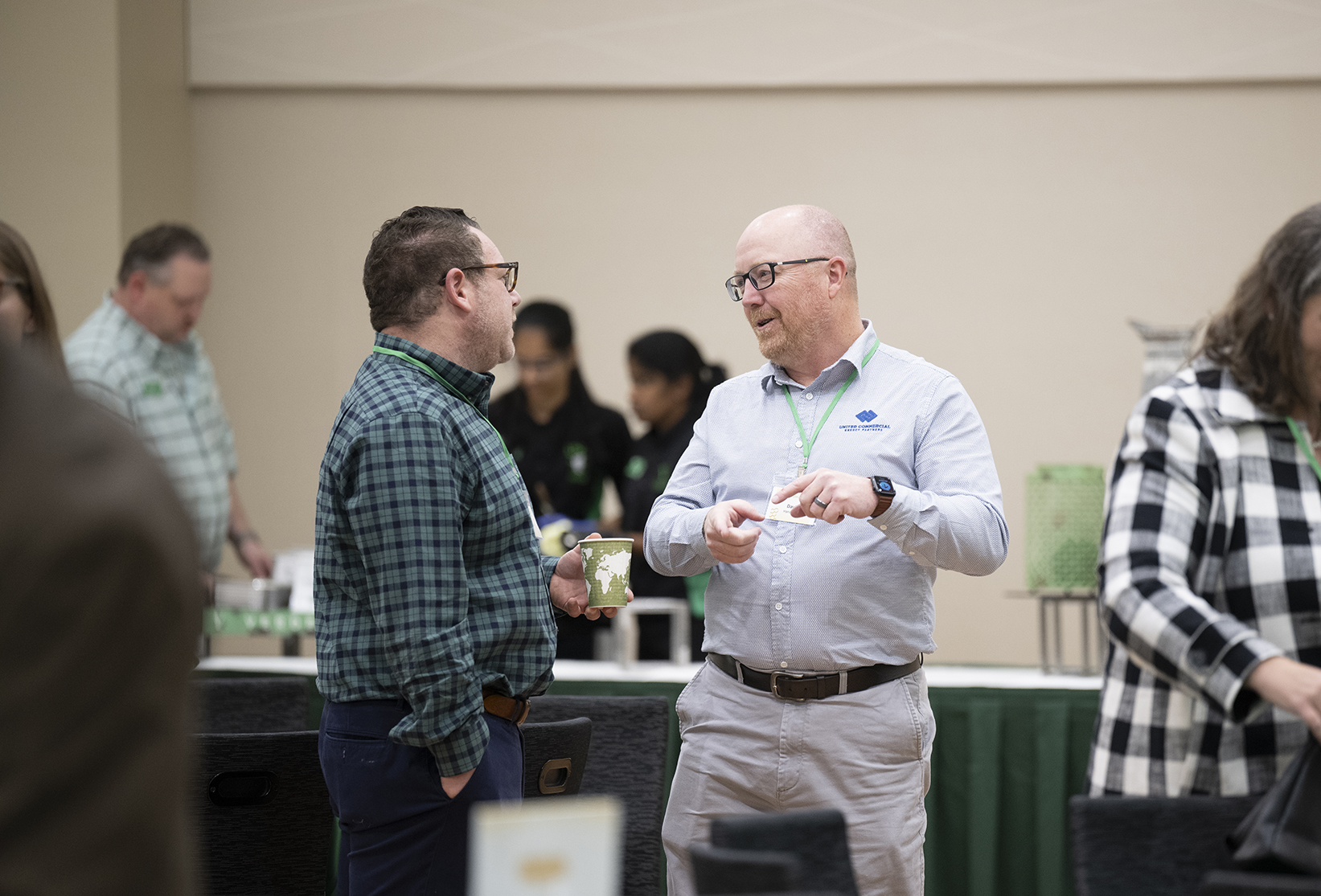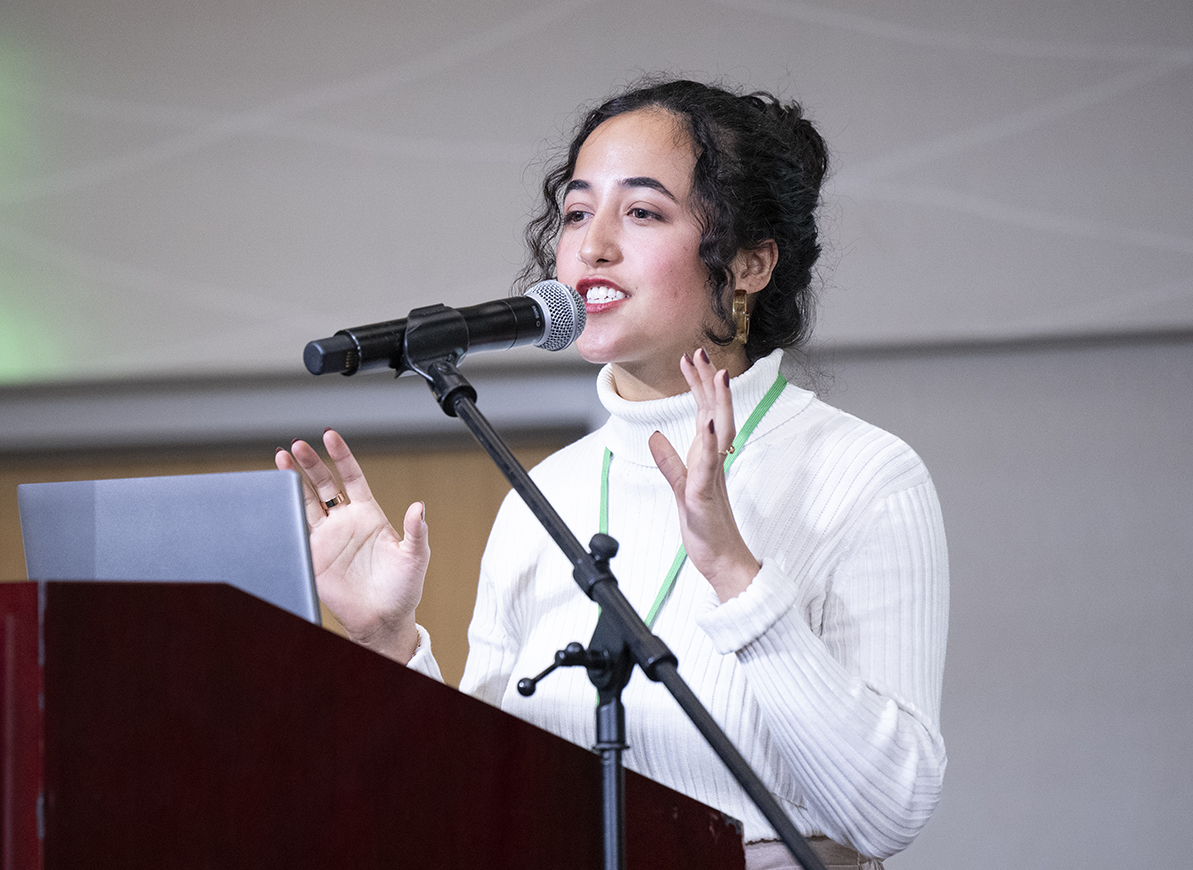Our sustainability challenges will require more holistic, interdisciplinary solutions...
Building a more sustainable world means going beyond addressing environmental issues alone.
“Our sustainability challenges will require more holistic, interdisciplinary solutions and working outside higher education, partnering with experts in industry, government and nonprofits,” says Amie Lund, director of UNT’s Advanced Environmental Research Institute and an associate professor of environmental toxicology.
That collaborative spirit is one of the core ideas of AERI, a UNT interdisciplinary institute of research excellence. Faculty, staff and students from across the university work together with external collaborators on large research projects aimed to mitigate environmental problems in areas ranging from air and water quality to urban planning, public health and conservation biology.
This month, AERI brought that cooperative mindset into focus with its first conference, “Growing Sustainably: Partnering for a Resilient Future.” The Oct. 13 event gathered more than 125 professionals from university, industry and government sectors for discussions around prevalent sustainable issues as well as presentations of current research endeavors and practices in the field. The event included keynote talks, panel discussions, a student research competition and networking opportunities.
“Our goal for organizing this conference was to cultivate discussions across local public and private sectors and nonprofit organizations to build collaborations, foster innovations and workforce initiatives for our sustainable and resilient future,” Lund says during her opening remarks at the conference.
Cultivating Access to Nature
The conference’s opening keynote speaker, Robert Kent, associate vice president and Texas state director for the Trust for Public Land, discussed how increasing access to natural spaces can create healthier, more resilient cities. The North Texas region is one of the fastest-growing areas in the nation, and with that growth comes new challenges around sustainability — from water quality and urban heat islands to mobility and transportation, public health and economic equity.

“Our parks, our trails, our green spaces can help solve some of our region’s biggest economic, social and environmental challenges,” says Kent, a Dallas native.
Kent shared success stories from the Trust for Public Land’s 10-Minute Walk Program, an initiative that engages city governments, corporate partners and communities in innovative projects to ensure everyone has access to a park within a 10-minute walk of their home.
As one of the first major cities to join the initiative, Dallas is working with TPL to transform its unused public land into vibrant green spaces through projects like the Dallas Community Schoolyards Program, which transforms public school playgrounds into neighborhood parks accessible to the community after school hours, and South Oak Cliff Renaissance Park, a once neglected piece of urban land surrounding South Oak Cliff High School that has been developed into a modern, solar-powered park designed by and for the area’s residents.
To Kent, these green spaces are a testament to the Trust for Public Land’s mission to create healthy, livable communities that prioritize equity, health, climate resilience and community.
“Through collaboration and optimism, we are transforming the North Texas region in unimaginable and extraordinary ways.”
Urban Development and Sustainability – Contemporary Challenges
Following Kent’s keynote, leaders from government, industry and UNT gathered for a panel discussion on contemporary challenges in urban development and how their fields are championing creative solutions for a more sustainable future.
“Data is king now, so we see our company as being not only just energy managers — we’re going to be data managers,” says David Handwork, chief engineer for United Commercial Energy Partners.
You’re going to see a whole portfolio of different technologies tomorrow that are just concepts today.
An expert in helping public and private clients forge a path to net zero through renewable energy, energy conservation and facilities optimization, Handwork sees technology as the key to sustainable growth. In order to leverage that technology, the future workforce must have both a deep understanding of data analysis and the technical skills to put that data to use as they help companies make informed decisions.
As director of environmental compliance for PepsiCo Foods North America, Keith Massa leads the development of strategies and programs to meet the company’s energy efficiency and broader sustainability goals. Through sustainability initiatives like PepsiCo Positive, the global leader in food sustainability is working toward a negative carbon footprint throughout its production process, from drastically reducing water usage and greenhouse gas emissions to responsibly sourcing ingredients and building circular and inclusive value chains through partnerships with companies like Walmart and Tesla
“I think the biggest challenge that we all face is technology,” Massa says. “Five to 10 years from now, we’re going to have new technologies — we’re going to have to. You’re going to see a whole portfolio of different technologies tomorrow that are just concepts today.”

Lewisville City Manager Claire Powell is proud of the city’s transformation into a place where thousands of new families choose to live and work each year.
“The downside is we can’t keep up with the growth — on infrastructure, on providing water, on providing enough parks where the people land in our community,” she says.
Three years ago, as part of its commitment to the 10-Minute Walk Program, Lewisville engaged a group of AERI researchers — including faculty and students in public administration and geography and the environment — to help plan and develop a new park. The project transformed into the CLIDE Award-winning Healthy Infrastructure Plan, a citywide initiative and UNT collaboration to improve residents’ health and provide equitable access to green space and critical infrastructure.
Mohit Patel, UNT’s campus energy manager, is using his position to shift the narrative around sustainability.
“Whenever we talk about solar or renewables, wind energy or geothermal heat pumps, people start thinking about the initial cost,” says Patel, who oversees UNT’s long-term commitment to improving efficiency and reducing overall energy consumption across campus.
“They don’t think about what we are going to be facing in the next 10 to 15 to 20 years. That’s one of the issues I face every day — how to make people understand to move ahead, to stop thinking about the return on investment and start building an infrastructure.”
Future and Emerging Issues in Sustainability in North Texas and Nationwide
The next panel addressed sustainable challenges across water, land use and ranching, energy and business with an emphasis on looking toward the future. Panelists also delved into discussions about the growth of sustainability as a field of its own and its evolving workforce needs, as well as the key role academic collaborators have played in innovation.
Philip Boyd, vice president of science and research for Dixon Water Foundation, emphasized the value of engaging with external collaborators — including researchers in the UNT College of Science — to fulfill the foundation’s mission to promote healthy watersheds through good land management of working cattle ranches.
“The way it helps strengthen our sustainability efforts is it really increases our understanding and ability to communicate what we’re doing,” Boyd says. “We’ll leverage our ranches as pilots for different [research] initiatives that are going on … We can absorb some of that risk and use partnerships to improve the model and improve the economy around it.”

Protecting and conserving water resources is on the mind of Zeke Campbell as well. As assistant deputy for water treatment and conveyance at the North Texas Municipal Water District, he oversees the operations and maintenance of seven water treatment plants, 700 miles of raw and treated water transmission pipelines and 14 major pump stations.
With the population growth expected to continue in North Texas, the regional water district has an eye on ensuring the resiliency of its water supplies and infrastructure.
“We have maybe 5,000 people a year moving into our service area, and they aren’t bringing water with them,” Campbell says. “… We have to find twice the amount of water sources to meet our growing demand as we have in our history. That’s a big challenge for us.”
Campbell says the regional water district has achieved a lot of success through its water conversation efforts, but conservation alone is not enough. It needs more water sources. Currently, the district is exploring several strategies to increase the water supply, including reuse water, groundwater and securing new water sources.
Last year, it celebrated the completion of Bois d’Arc Lake, a new water reservoir in Fannin County. The lake not only provides much-needed water, but a new natural recreation space which features newly planted trees and restored grasslands and wetlands — allowing a viable opportunity for researchers like UNT graduate student Tessa Boucher to examine how the restoration has changed wildlife populations like birds.
We need system thinkers. We need communicators. We need people who are willing to jump in and solve problems...
As president and managing partner for Nanban ESG Solutions, Preetha Prabhakar works closely with companies to integrate social and environmental responsibility into their operations and help them achieve their sustainability goals. She says the need for a sustainably-minded workforce will only continue to grow.
“We need to make sure the next generation understands there are plenty of opportunities in sustainability,” Prabhakar says. “It is not like the previous 10 years when nobody understood what sustainability was. Today, the awareness is awesome.”
“[We need to think about] how can local communities, local companies come together and make sure there is a bridge that we can build to make sure these students are educated about sustainability in corporate real-world problems so they can give us better solutions than we could think about.”
And what does the future workforce of renewable energy look like?
Michelle Finchum, director of sustainability for Pine Gate Renewables, admits there are still many unknowns. Pine Gate Renewables develops and operates large-scale solar and energy storage projects across the U.S. — including one of its newest in Denton County where it is partnering with AERI researchers to explore sustainable land management practices. In their work, Pine Gate Renewables employees must be comfortable adapting and willing to come up with solutions to new problems on the fly.
“We need system thinkers. We need communicators. We need people who are willing to jump in and solve problems and be told, ‘oops, that wasn’t quite the problem you’re trying to solve, go solve another problem,’ and to smile and keep going,” Finchum says.
ESG at DFW Airport
The concluding keynote, presented by Robert Horton and Sandy Lancaster from Dallas/Fort Worth International Airport, provided an overview of the environmental, social and governance considerations a large international airport must navigate in its operation.
“We consider ourselves an asset of the community, so when we talk about the reason we invest in sustainability, it’s because we want to be responsible in the way that we practice. Our role at the airport is to protect people and then to protect natural resources,” says Horton, vice president of environmental affairs and sustainability at DFW Airport.

In doing that, Horton and his team consider a range of factors from air quality, water usage and energy performance to health, safety and wellness.
DFW Airport has been a leader in the sustainability space. In 2016, it was the first carbon-neutral airport in North America and currently, it's working toward net-zero carbon emissions by 2030 — 20 years ahead of the proposed global industry goal for this benchmark.
Lancaster, assistant vice president of environmental development programs at DFW Airport, shared specifically about one environmental aspect of the airport that requires engagement of community members and local governments: noise.
The problem is unique in that the airport’s control over noise is minimal, yet the airport has to answer for it, Lancaster says.
So, to influence the impact of noise, the airport works with several partners, such as collaborating with local cities to raise awareness about development within flight paths; monitoring through flight schedules and noise monitors to measure the noise contributed specifically by the airport and engaging with communities to keep them informed about airport development and operational changes that might impact noise levels.
The next challenge on the horizon for noise will be the electric vertical take-off and landing aircraft (eVTOLS), which are the next frontier in air mobility. Lancaster is on a NASA team researching the noise from eVTOLS considering best practices for engaging with the communities and understanding the impact these aircraft will have on established policy.
“The right thing to do is to tell the community that the challenge is that this market is developing so fast, we have as many questions as the community would have … but these are coming, and we know they are our future.”
Shaping the Future
The second half of the day was themed “Shaping the Future” and featured a student research pitch competition as well as lightning talks from industry representatives at Haskell and United Commercial Energy Partners.

Eighteen students, with one duo team, presented their current research in fields ranging from philosophy to chemical engineering. Students of all levels, including local high schoolers, participated. They each had three minutes to convey their research topics and possible impacts while being judged on their presentation skills.
Winners earned cash prizes from $100 to $1,000 for their presentations. First place went to Bernardo Vargas, a graduate student in philosophy and religion. His research focuses on the resiliency of people living in informal housing and how they cope with fewer resources while creating their own joy.
Michael Biancardi’s project examining the impact of increasing air pollution during rush hour took second place, Supuni Silva received third place with her research on building young students’ confidence in STEM and Brooke Poplin’s work on how urbanization affects Harris’s hawks earned third.
Honorable mentions went to projects on efforts to rebuild wild turkey populations (Clarissa Molina), creating low-cost sensors for air pollution monitoring (Luke Liu and Maximus Huang) and exploring how communities of different income levels treat vacant lots in their neighborhoods (Ellen Christensen).
Amanda Fuller, Amanda Lyons and Heather Noel contributed to this story.
